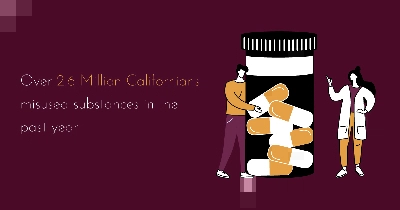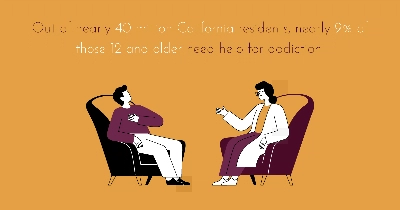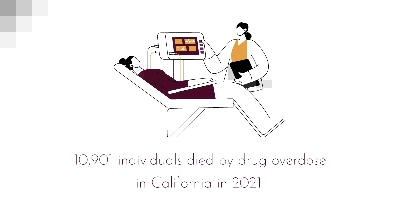What to Look For In a California Rehabilitation Center
Read on to learn more about what rehab entails and what you should look for in a California rehabilitation center.
What Is Rehab?
Substance use disorder is a chronic condition with many varying health implications. Rehab is often a vital stepping stone for individuals on their path to recovery. It helps individuals address challenges like substance use and mental health concerns. Attending a California rehabilitation center can help individuals get the care and support they deserve.

California Rehab Goals and Opportunities
- Inpatient facilities
- Outpatient clinics
- Community-based programs
What Is Rehab For?
- Assessment and evaluation: The first step in a California rehabilitation center is often an assessment and evaluation by a qualified mental health professional. This assessment can help to determine the individual’s specific needs.
- Detoxification: For individuals living with substance use, detoxification is often the next step in the rehab process. This involves removing the drug or alcohol from the body under medical supervision.
- Therapy and counseling: Mental health and substance use rehab typically involves various therapy and counseling services. These services help individuals address the root causes of their health conditions. They also develop healthy coping strategies to manage their symptoms.
- Medication management: Medication management is also essential to a rehab treatment plan. This involves working with a psychiatrist to find the proper medication to manage symptoms.
- Support groups: Many mental health and substance use rehab programs offer support groups. It helps individuals connect with others who are going through similar experiences.
- Aftercare planning: Aftercare planning is an important step to help individuals continue their recovery journey after rehab has been completed.
What Types Of Rehab Programs Exist?
Inpatient Rehab
Inpatient rehab programs require individuals to stay at a treatment facility 24/7 for a set period. They typically range from 30-90 days. These programs offer intensive therapy and support in a structured environment.
They are best suited for individuals with severe mental health or substance use disorders.3
Outpatient Rehab
Outpatient rehab programs allow individuals to receive treatment while living at home and attending work or school. These programs typically involve attending therapy or counseling sessions a few times a week.
Outpatient rehab is best suited for individuals with mild to moderate mental health or substance use disorders.
Partial Hospitalization Programs (PHP)
Partial hospitalization programs offer a high level of care in a more flexible environment. Individuals attend therapy and other services during the day.
Then, they can return home at night. PHP programs are typically for individuals who require a higher level of care than outpatient programs but do not require 24/7 supervision.
Intensive Outpatient Programs (IOP)
Intensive outpatient programs at a California rehabilitation center offer a more intensive level of care than traditional outpatient programs. Individuals attend therapy and other services several times a week for several hours.
IOP treatment is typically for individuals who need a more structured treatment plan than traditional outpatient therapy.
Dual Diagnosis Programs
Dual diagnosis programs are designed for individuals with a mental health disorder and a substance use disorder. These programs offer specialized treatment to address both issues simultaneously.
Holistic Rehab Programs
Holistic rehab programs take a whole-person approach to treatment. They address physical health, nutrition, and other lifestyle factors impacting recovery.
Holistic rehab programs involve a combination of therapy, mindfulness practices, exercise, and nutrition education. They are best suited for individuals interested in taking a more holistic approach to their recovery.

How Prevalent Is Substance Use in California?
Substance use disorder is a significant public health issue in California. According to recent Substance Abuse and Mental Health Services Administration data, 8.8% of California individuals 12 and over reported having a substance use disorder in the past year. That is over 2.9 million individuals.4
Scope and Risk Factors of Substance Misuse
How Effective Is a California Rehab Center in Helping People Achieve Sobriety and Wellness?
- The individual’s level of commitment to the process
- The quality of the treatment program
- The individual’s specific needs and circumstances
Factors that Influence Effectiveness of Treatment
Types of Services in Rehab
Medical Detoxification
Inpatient/Residential Treatment
- Individual and group therapy
- Medical and psychiatric care
- Support services
Outpatient Treatment
Counseling/Therapy
- Cognitive-behavioral therapy
- Motivational interviewing
- Family therapy
- Holistic therapy
A Closer Look at Cognitive Behavioral Therapy
Support Groups
Medication-Assisted Treatment (MAT)
Treatment involves using medications to help individuals manage cravings and reduce the risk of relapse. Medication used can include:
- Methadone
- Buprenorphine
- Naltrexone
A Closer Look at MAT
Aftercare
Aftercare is often crucial in a California rehabilitation center in order to help reduce the rate of relapse in individuals after rehab has been completed. Examples of aftercare programs include ongoing counseling, support groups, and case management.
How To Find The Right California Rehabilitation Center For You

Assess Your Needs
Check Accreditation
Consider the Location
Consider whether you want to attend a California rehabilitation center close to home or farther away. Being close to home can provide a sense of familiarity and support. You get distance from triggering environments.
Meanwhile, attending a program farther away can offer more privacy.
Check Insurance Coverage
Research Treatment Approaches
Read Reviews
Ask for Recommendations
How To Get The Most Out of a California Rehabilitation Center

Be Open-Minded
Take an Active Role
Develop a Support Network
Practice Self-Care
- Getting enough sleep
- Eating a healthy diet
- Exercising regularly
- Practicing stress-management techniques such as meditation or yoga
What is Emotional Health and Well-Being? A Closer Look
Set Realistic Goals
Embrace a Sober Lifestyle
- Avoiding people or situations that are a risk to your recovery
- Developing new hobbies or interests
- Finding healthy ways to cope with stress and negative emotions

What Type of Rehab Does Rise Above Treatment Offer?
Inpatient Program
Outpatient Program
Intensive Outpatient Program
Evidence-Based Treatment Methods
Individual and Group Therapy
Family Therapy
Holistic Therapies
Reach Out to Rise Above Treatment and Begin Healing
Our California rehabilitation center treatment programs are designed to provide the tools and support you need to achieve lasting recovery.
Get in touch with us today, and we will work with you every step of the way during your recovery, equipping you with the tools and resources for the long-lasting wellness you deserve.
Table of Contents
Are you ready to Rise Above your mental health and addiction challenges?
Reach out to us today. Let us provide the support and guidance needed for sustainable recovery and wellness, allowing you to lead the happy, healthy, and fulfilling life you deserve.
Resources
- 1https://pubmed.ncbi.nlm.nih.gov/32037876/
- 2https://pubmed.ncbi.nlm.nih.gov/34033404/
- 3https://pubmed.ncbi.nlm.nih.gov/26996093/
- 4https://www.chcf.org/publication/2022-edition-substance-use-california/
- 5https://www.samhsa.gov/data/sites/default/files/report_2790/ShortReport-2790.html
- 6https://pubmed.ncbi.nlm.nih.gov/26168063/


